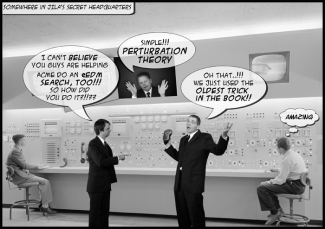The mission to find the electron electric dipole moment (eEDM) recently took a menacing turn. Chief Eric Cornell and his protégés were already hard at work characterizing the hafnium fluoride ion (HfF+). Their goal was to be the first in the world to complete the mission. In their choice of molecule, they owed a lot to JILA theorists Ed Meyer and John Bohn (a.k.a. Agents 13 and 86), who had taken the theory world by storm in 2006 when they devised a simple and straightforward method for the evaluation of molecular candidates for an eEDM search.
In their initial effort, the theorists used simple physics ideas in lieu of complex analytical techniques. Two years ago, their method was able to replicate all previous complex and painstaking analyses within a factor of 2.
"Missed it by THAT much!" Agent 86 noted recently inside this reporter's cone of silence.
In an unexpected turn of events, the JILA theorists were recently asked by the ACME collaboration from Yale and Harvard (the evil competition) to provide similar eEDM theory work. Bohn and Meyer said yes! "No matter who wins, JILA wins," Agent 86 explained, seemingly oblivious to the possibility that ACME might be an arm of KAOS. Chief Cornell saw it differently, at least in public. Both recalled the terse conversation that ensued:
Chief: "Please don't tell me you’re actually doing theory for the forces of ACME."
Agent 86: "Chief, we're doing theory for the forces of ACME."
Chief (slaps forehead): "I asked you not to tell me that!"
Agent 86: "Sorry about that, Chief."
Well maybe not all that sorry. After all, Meyer and Bohn discovered that thorium oxide (ThO) has the strongest internal electric field they’d ever evaluated. So, as they reported to ACME, ThO is perhaps the best candidate yet identified for an eEDM experiment. More importantly (for JILA), a similar molecule, ThF+, was found to be just as good as ThO. And, ThF+ would work in the Chief’s ion experiment!
In their work for ACME, agents 13 and 86 coaxed a more realistic wave function out of their MOLPRO software. As a result, their method has become competitive with those of all other theorists. Their new and improved analytical technique can now predict the internal electric fields of any molecule within 25% of anyone else — including researchers who use rooms of computers to perform "mathematical analyses on steroids" when tackling the same problem. "In a head to head contest between a Moped and a tank, the Moped won," Agent 86 explained.
So how did they do it?
"We just used perturbation theory, the oldest trick in the book," Agent 86 explained.
At times, Agents 86 and 13 seemed downright gleeful that ACME and Chief Cornell were now "going for the gold." After all, if either group measures an eEDM, there will be strong support for physics beyond the standard model. Or, as Agent 13 said, speaking from inside this reporter's Swiss ball, "If they find an eEDM, it may help explain why there’s more matter than antimatter in the Universe."
The Chief added, "Agent 86 somehow always ends up thwarting KAOS. But sometimes, if I didn't know he was a crack atomic physicist working for CONTROL, I'd swear..." - Julie Phillips




